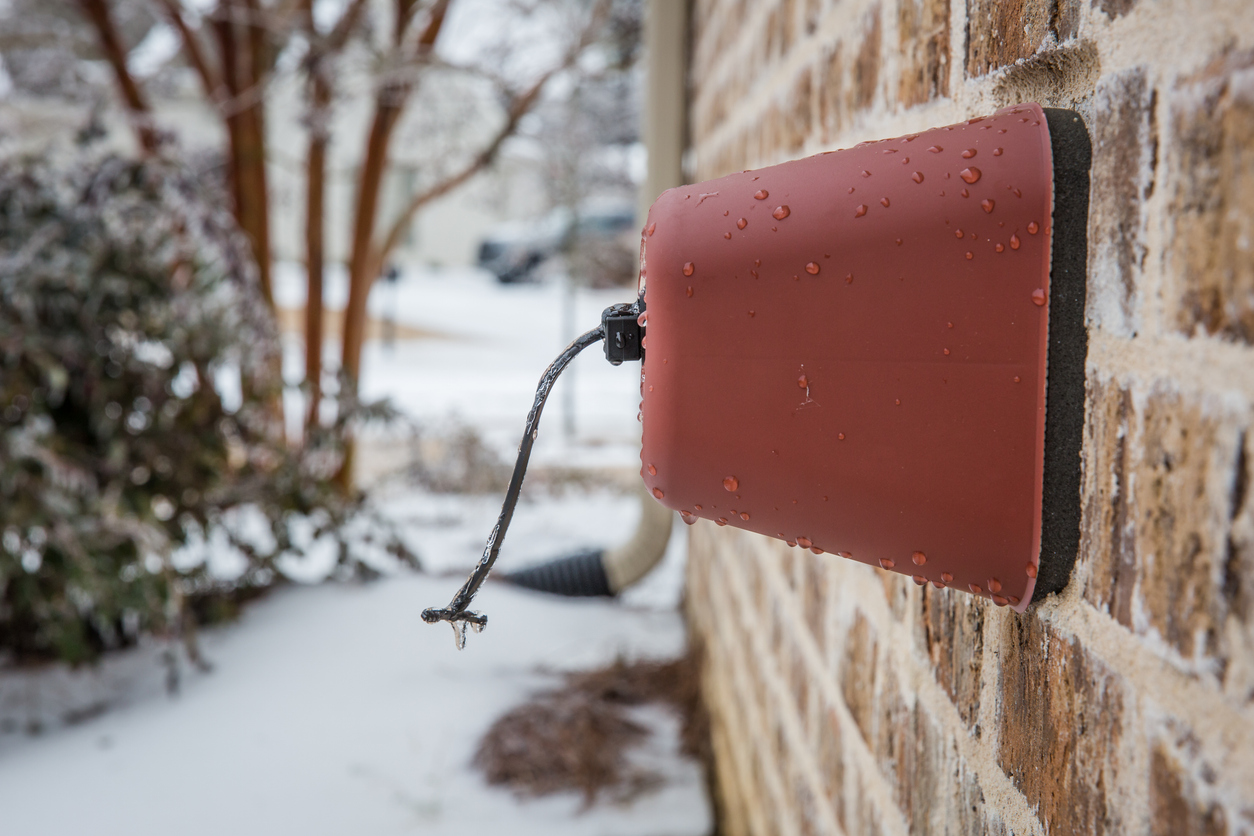Winter weather can wreak havoc on your plumbing, and one of the most vulnerable areas is your outdoor faucets and hose bibs. If not properly winterized, freezing temperatures can cause outdoor faucets to freeze and burst, leading to costly water damage inside your home.
A frozen hose bib doesn’t just mean you can’t use it—it can also lead to cracked pipes that leak behind your walls, potentially causing thousands of dollars in repairs. The good news is that a few simple preventative steps can protect your home from this common winter plumbing hazard.
Let’s break down how to recognize a frozen hose bib, how to prevent it from bursting, and what to do if your outdoor faucet has already frozen.

1. How to Tell If Your Outdoor Faucet is Frozen
Even if you’re not using your outdoor faucet in winter, it’s crucial to check it periodically for signs of freezing. A frozen hose bib can go unnoticed until warmer weather causes the ice to melt, revealing a major leak.
Signs Your Outdoor Faucet is Frozen:
- No water comes out when you turn on the faucet
- Ice or frost buildup around the faucet or pipe
- A bulging or cracked pipe near the hose bib
- Dripping or leaking water inside the home when the faucet is turned on
If you notice any of these signs, act quickly to prevent a burst pipe from causing further damage.

2. What Happens If a Hose Bib Freezes?
When temperatures drop below freezing, any water trapped inside an outdoor faucet or pipe can turn into ice. Since water expands when it freezes, this puts pressure on the pipes, potentially causing them to crack or burst.
The real damage occurs when the ice melts—suddenly, water can start leaking inside your walls or basement, leading to mold, drywall damage, and costly repairs.
That’s why preventing frozen outdoor faucets is key to avoiding plumbing disasters.

3. How to Prevent Frozen Hose Bibs and Outdoor Faucets
Preventing frozen hose bibs is simple and inexpensive, but it requires taking action before the coldest months hit.
Winterizing Your Outdoor Faucets:
✅ Disconnect Garden Hoses – Always remove hoses from outdoor faucets before temperatures drop. Any leftover water in the hose bib can freeze and cause damage.
✅ Shut Off and Drain Outdoor Faucets – If your home has an outdoor water shut-off valve, turn it off and drain any remaining water from the faucet.
✅ Install a Hose Bib Cover – Foam faucet covers provide insulation and protect your outdoor faucets from extreme temperatures. They’re inexpensive and highly effective.
✅ Upgrade to a Frost-Free Hose Bib – Unlike standard outdoor faucets, frost-free hose bibs prevent water from sitting inside the pipe, reducing the risk of freezing.
✅ Insulate Exposed Pipes – If the pipe leading to your outdoor faucet is in an unheated area (like a garage or basement), wrap it in foam pipe insulation to keep it warm.
Taking these steps before winter hits can save you from expensive plumbing repairs.

4. What to Do If Your Hose Bib Is Already Frozen
If you turn on your outdoor faucet and nothing comes out, the pipe may already be frozen. Here’s what to do:
1️⃣ Turn off the water supply to the outdoor faucet to prevent further pressure buildup.
2️⃣ Gently apply heat to the faucet and pipe using a hairdryer, space heater, or warm towels. Do NOT use an open flame, as it can damage the pipe.
3️⃣ Check for leaks – Once thawed, turn the faucet on slightly and check for any dripping water inside your home.
4️⃣ If you find a leak, call a professional plumber immediately to prevent further water damage.
If your hose bib has burst or the pipe is cracked, professional repair or repiping may be necessary.

5. When to Call a Plumber for Outdoor Faucet Issues
If you suspect that your hose bib or outdoor plumbing is frozen or damaged, it’s crucial to act fast. A small leak can quickly escalate into a major water damage situation, especially in winter when freezing and thawing cycles put extra stress on your plumbing.
At Da Vinci’s Best Plumbing, we specialize in:
✔ Frozen pipe repairs – Fixing cracked or burst pipes caused by freezing temperatures.
✔ Hose bib replacement – Installing frost-free hose bibs for long-term protection.
✔ Winter plumbing maintenance – Ensuring your entire home’s plumbing system is protected from winter damage.
Ignoring a frozen or damaged hose bib can result in costly emergency repairs. Get ahead of the problem now to prevent a winter plumbing disaster!

Protect Your Home from Winter Plumbing Damage – Call Da Vinci’s Best Plumbing Today!
Don’t let frozen outdoor faucets cause major water damage inside your home. Call Da Vinci’s Best Plumbing at (971) 220-8685 or visit our contact page to schedule a winter plumbing inspection today!

